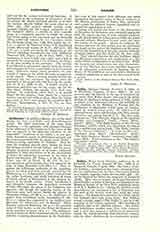

Sadducees. —A politico-religious sect of the Jews during the late post-Exilic and New-Testament period. The older derivation of the name from tsaddiqim, i.e. the righteous; with assumed reference to the adherence of the Sadducees to the letter of the Law as opposed to the pharasaic attention to the superadded “traditions of the elders”, is now generally discredited mainly on philological grounds and the term is associated with the proper name “Sadoc”, Sadducee being equivalent to Sadokite. They became the dominant priestly party during the Greek and Roman period of Jewish history, and the name, whether bestowed seriously or in irony, originated doubtless in their pretensions to be the descendants of Sadoc, the high-priest prominent in the times of David and Solomon (III Kings, i, 8, 26, 32; ii, 35; I Par., xxix, 22; cf. Ezech., xl, 46; xliii, 19; etc.). As a prominent political party they first appear in the reign of John Hyrcanus (135-105 B.C.). They espoused the hellenizing tendencies of the Asmonean princes in which they were strongly opposed by the Pharisees (q.v.), or Separatists, a party evolved from the earlier Assideans, and which abhorred all forms of Greek culture as detrimental to the religious interests of the Jewish nation. Under Aristobulus I and Alexander Jannaeus, the immediate successors of John Hyrcanus, the power of the Sadducees was supreme, and though the opposing faction of the Pharisees came into favor during the regency of Alexandra Salome (78-69 B.C.), the Sadducees regained their ascendancy under Aristobulus II (69-63 B.C.) whom they supported in his conflicts with Hyrcanus II, Antipater, and the Romans. When Pompey captured Jerusalem (63 B.C.) he executed many of their leaders, as did also Herod the Idumean on his accession to power (37 B.C.). The Sadducees retained, however, their traditional priestly functions and also a varying preponderance in the Sanhedrin, but even in this respect their influence was much diminished through the policy of Herod and later of the Roman procurators of Judea, who, arbitrarily and mainly for political reasons, appointed and removed the high-priests at will.
During this period and down to the destruction of Jerusalem the Sadducees were naturally unpopular with the masses because of their marked tendency to side closely with the ruling power, while the patriotic and exclusive Pharisees became more and more the leaders of the people. Among the religious differences between the two parties may be mentioned the denial on the part of the Sadducees of the resurrection, the immortality of the soul, and the existence of angels (Matt., xxii, 23; Mark, xii, 18; Acts, xxiii, 8). They rejected likewise the oral traditions which the Pharisees maintained and emphasized as a Divinely ordained supplement to the written law. While the tenacity and exclusiveness and other characteristics of the Pharisees have been indelibly impressed on all subsequent generations of Judaism, the influence of the indifferent and materialistic Sadducees vanished completely as soon as the Jews ceased to be a nation.
JAMES F. DRISCOLL

